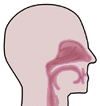  |
||
 |
November 2020Description of Loss of SmellMost clinicians label smell loss as anosmia. This term does not accurately describe the clinical condition. ANOSMIA describes the total loss of ability to detect or recognize odors at any concentration. While this does occur it is extremely rare. Most patients who exhibit smell loss have HYPOSMIA which implies the ability to detect and/or recognize some odors, usually strong ones. This is an important clinical distinction since patients with HYPOSMIA represent the major group of patients with smell loss and are the patient group most amenable to treatment once the underlying cause is identified. Indeed, HYPOSMIA can be defined by several clinical states. Type I HYPOSMIA describes patients who can detect odors but cannot recognize any odor. Type II HYPOSMIA describes patients who can detect and recognize odors at higher levels of concentrations than normal people can. Type III HYPOSMIA describes patients who can detect and recognize odors at normal concentrations but with difficulty in characterizing odor intensity – i.e., ability to appreciate odor strength is impaired. Clinically most patients with HYPOSMIA of any type complain that they cannot smell any odor which makes the description of ANOSMIA clinically understandable. However, ANOSMIA is a very rare condition with most patients exhibiting various types of HYPOSMIA. See Henkin RI, Levy LM, Fordyce A. Taste and smell function in chronic disease: A review of clinical and biochemical evaluation of taste and smell dysfunction in over 5000 patients at The Taste and Smell Clinic in Washington, DC. Am J Otolaryngol. 2013;34:477-489 for more details. |
|